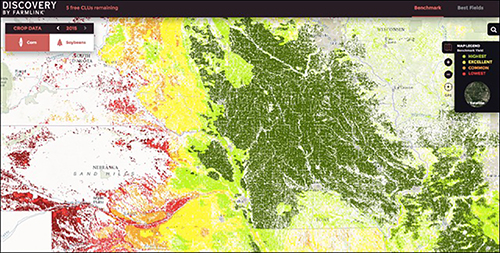On his third-generation family farm in east-central Illinois, Ron Haase needs to be equal parts farmer and soothsayer. That’s because, due to the nature of large-scale corn and soy farming, he pre-sells a portion of his soybean and corn crops to grain traders well before they are harvested. In fact, he and other farmers often make deals even before the seeds germinate.
In doing so, he must set the price based on an educated guess, on what he expects the yield to be and on what he predicts a good market price might be in the coming months. To inform his decisions, Haase this year began using MarketVision, a data-analytics platform from FarmLink, a Kansas City, Mo., company that predicts the best time for farmers to sell their crop, based on real-time updates regarding the crop’s yield potential, historical yield data for the region, and current and historical market pricing. The system can also analyze historical yield data culled from sensors attached to a farmer’s combine. If the farmer has a weather station to collect temperature and humidity levels on the farm, as well as soil moisture and wind direction and speed, that station could transmit data to MarketVision’s cloud-based platform to help estimate the farmer’s likely yield, and thereby inform pricing guidance.

The MarketVision platform analyzes past weather and grain marketing information from DTN, a provider of agricultural business-management tools, to assess yield, price and farm-performance values. Through FarmLink’s collaboration with DTN, MarketVision collects “national fair-value indicators for corn and soybeans (with adjustments for local markets), perspectives on seasonal growing conditions and the impact of weather to provide field-level profit potential for subscribers,” explained Jennifer Goldston, FarmLink’s VP of communications, via email.
FarmLink co-markets MarketVision with DTN, through a subscription service.
“It’s like a futures market, because they have to sell before they harvest, and the software is doing a lot of the work to predict the harvest,” says Mark Rolston, founder of Argodesign, a design firm that helped FarmLink establish the program’s user interface.
Robert McClure, FarmLink’s chief data scientist, says independent farmers are looking for more automated yield forecasts, and want to find ways in which to save time on pricing research. Plus, he says, accurately predicting yield—and obtaining a good market price for crops—is more important than ever.
“Until this year, commodity prices have been good, but now commodity prices are down, so this is a time you really need to focus on efficiency,” McClure states. “Understanding how to get a fair price for grain is important.”

